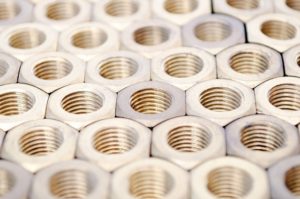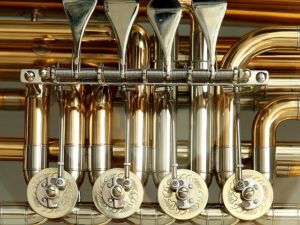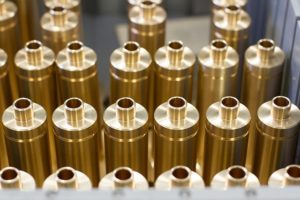When copper was discovered around 9000 years ago, no one thought it would come to be the most investigated metal on the planet. Almost immediately, it was held in high esteem alongside precious metals like gold and silver. There are a number of reasons why it didn’t take long before copper became a staple material for a vast range of applications at the time.
- It’s more abundant than gold or silver, and therefore cheaper.
- Other metals like iron and aluminum, which are widely used today, had not been discovered yet.
- It exhibits many useful properties that can’t be found in gold and silver or even in other metals that were discovered later.
- It can easily be alloyed with other metals.
Of all the qualities of copper that were highly exploited in ancient metallurgy, perhaps the most valuable is its ability to be conveniently combined with other metals. They could do it with silver and gold but not as efficiently as with copper. Although noble or nonreactive to other elements, copper exhibits limitless alloying possibilities.
Contrariwise, combining metals only came into existence over a thousand years after copper’s discovery. It started after metallurgists found out that they could produce a harder and more durable material when they mix a little bit of tin with copper. This material was called bronze. People became so obsessed with bronze that they created just about anything with it from weapons and shields to furniture and cookware. The supply of objects made of pure copper started to run low and then the world suddenly transitioned to the Bronze Age.
Fast forward a few thousand years and yet another copper-based material was unearthed. This time zinc was the additive in the mixture. The material was later called brass, and like bronze, it also exhibits many useful properties. Its discovery marked the beginning of the endless quest for new materials made primarily of copper, and in the past couple of millennia, there have been more copper-based metals discovered than all the available basic industrial metals combined.
Despite the huge number of copper alloy variants commercially available today, they can all be classified under the two main copper alloys—bronze and brass. After all, copper merges most effectively with tin and zinc. The rest of the variants are simply improvements of the basic alloys. To better understand bronze and brass difference, here are some facts about them that every manufacturer, supplier, builder, or artisan should know.
Bronze
Bronze is one of the few metals that most people have heard of at least once. Although popular, it is also so elusive that not very many people are aware of its true nature and qualities. When asked to identify objects they know to be made of bronze, most would only be able to mention a few. Chances are the only bronze objects they know of are the bronze statues and bells they see in museums and churches. Certainly, though, there’s more to bronze than those applications.
Composition.
Standard bronze is made of about 88% copper and 12% tin. Either constituent can be increased or decreased to give way for additional elements, such as aluminum, manganese, nickel or zinc, and sometimes non-metals or metalloids such as arsenic, phosphorus or silicon. Bronze adopts the properties of these additional elements, becoming stiffer, more ductile and malleable, or of higher machinability.
Properties.
The most distinctive property of bronze is its salmon-like color and shade. It’s a tint darker and less reddish than copper and definitely less lustrous than natural brass. When exposed to the elements, bronze develops patina on its surface, immediately changing its color from dark brown to green. Patina protects the bronze from weathering and corrosion, and is responsible for bronze’s long life.
When it comes to strength and hardness, bronze does not disappoint. Thanks to modern metalworking technology that allows for the addition of other metals, such as aluminum and manganese, there are now bronzes that can withstand up to 68,000 psi of pressure. It’s no wonder some bronzes are utilized in marine fittings, bearings and pumps where high strength and hardness are required.
Applications.
Today’s bronze alloys are extremely flexible. They can be made into castings, extrusions, and forgings that play major roles in architecture, agriculture, and maritime construction. Many parts of pump housings, sporting equipment, and building doors and windows are made of very specific bronze alloys. Some bronzes are even used for oil and petrochemical piping, glass bottle manufacturing, and specialized anti-corrosive applications.
Brass
Despite being more recently discovered than bronze, most of brass’s unique properties have already been explored and exploited, and brass bronze difference has long been corroborated. There’s a whole new network of industries taking advantage of this metal’s potentials.
Composition.
As previously mentioned, brass is an alloy of copper and zinc. To improve its machinability, corrosion resistance, and mechanical properties, other metals such as arsenic, lead, and aluminum may be added. Brasses with higher proportions of copper usually have higher electrical conductivity.
Properties.
Brass has a lighter and more pleasing color and shade than bronze. Certain variations even appear very similar to gold, which is why many utilize bronze in architecture and interior design where a gold-like finish is desired. While brass is also extremely resistant to both freshwater and saltwater corrosion, it is weak when in contact with certain compounds, such as amine. Imprecise fusion of zinc may also lead to a type of corrosion called dezincification in which the zinc content of brass gradually leaches away, leaving only a porous copper structure behind.
Applications.
Many of the brasses people know of are found in items like door handles, lamps, and ceiling fixtures. Most brass musical instruments are also made of brass, hence the family name. It is also the basic material for many types of pipe fittings, nuts, and bolts. The casings for all kinds of ammunition are also made of brass, thanks to the metal’s low friction.
It is easier to identify the right type of copper-based metal to use for your project if you understand their properties. Unfortunately, you cannot just pick one or the other after comparing brass vs bronze because they each have unique properties. To help you identify the right type and grade of metal to buy, consult with metal experts from top suppliers like Rotax Metals. Not only do they have advanced knowledge in working with copper and its alloys, but they manufacture their own products as well.




